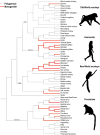Social Monogamy in Nonhuman Primates: Phylogeny, Phenotype, and Physiology
- PMID: 28704071
- PMCID: PMC6004613
- DOI: 10.1080/00224499.2017.1339774
Social Monogamy in Nonhuman Primates: Phylogeny, Phenotype, and Physiology
Abstract
Monogamy as a social system has been both a scientific puzzle and a sociocultural issue for decades. In this review, we examine social monogamy from a comparative perspective with a focus on primates, our closest genetic relatives. We break down monogamy into component elements, including pair-bonding and partner preference, mate guarding or jealousy, social attachment, and biparental care. Our survey of primates shows that not all features are present in species classified as socially monogamous, in the same way that human monogamous relationships may not include all elements-a perspective we refer to as "monogamy à la carte." Our review includes a survey of the neurobiological correlates of social monogamy in primates, exploring unique or common pathways for the elemental components of monogamy. This compilation reveals that the components of monogamy are modulated by a suite of androgenic steroids, glucocorticoid hormones, the nonapeptide hormones oxytocin and vasopressin, and other neurotransmitter systems (e.g., dopamine and opioids). We propose that efforts to understand the biological underpinnings of complex human and animal sociosexual relationships will be well served by exploring individual phenotypic traits, as opposed to pursuing these questions with the assumption that monogamy is a unitary trait or a species-specific characteristic.
Figures

References
-
- Ågmo A, Smith AS, Birnie AK, French JA. Behavioral characteristics of pair bonding in the black tufted-ear marmoset (Callithrix penicillata) Behaviour. 2012;149:407–440. http://doi.org/10.1163/156853912X638454. - DOI - PMC - PubMed
-
- Ahsan F. Fighting between two females for a male in the Hoolock gibbon. International Journal of Primatology. 1995;16(5):731–737.
-
- Alberts SC, Buchan JC, Altmann J. Sexual selection in wild baboons: from mating opportunities to paternity success. Animal Behaviour. 2006;72(5):1177–1196. http://doi.org/10.1016/j.anbehav.2006.05.001. - DOI
-
- Alvergne A, Faurie C, Raymond M. Variation in testosterone levels and male reproductive effort: Insight from a polygynous human population. Hormones and Behavior. 2009;56(5):491–497. http://doi.org/10.1016/j.yhbeh.2009.07.013. - DOI - PubMed
-
- Anderson ML. Evolution of cognitive function via redeployment of brain areas. The Neuroscientist. 2007;13(1):13–21. - PubMed
Publication types
MeSH terms
Grants and funding
LinkOut - more resources
Full Text Sources
Other Literature Sources
